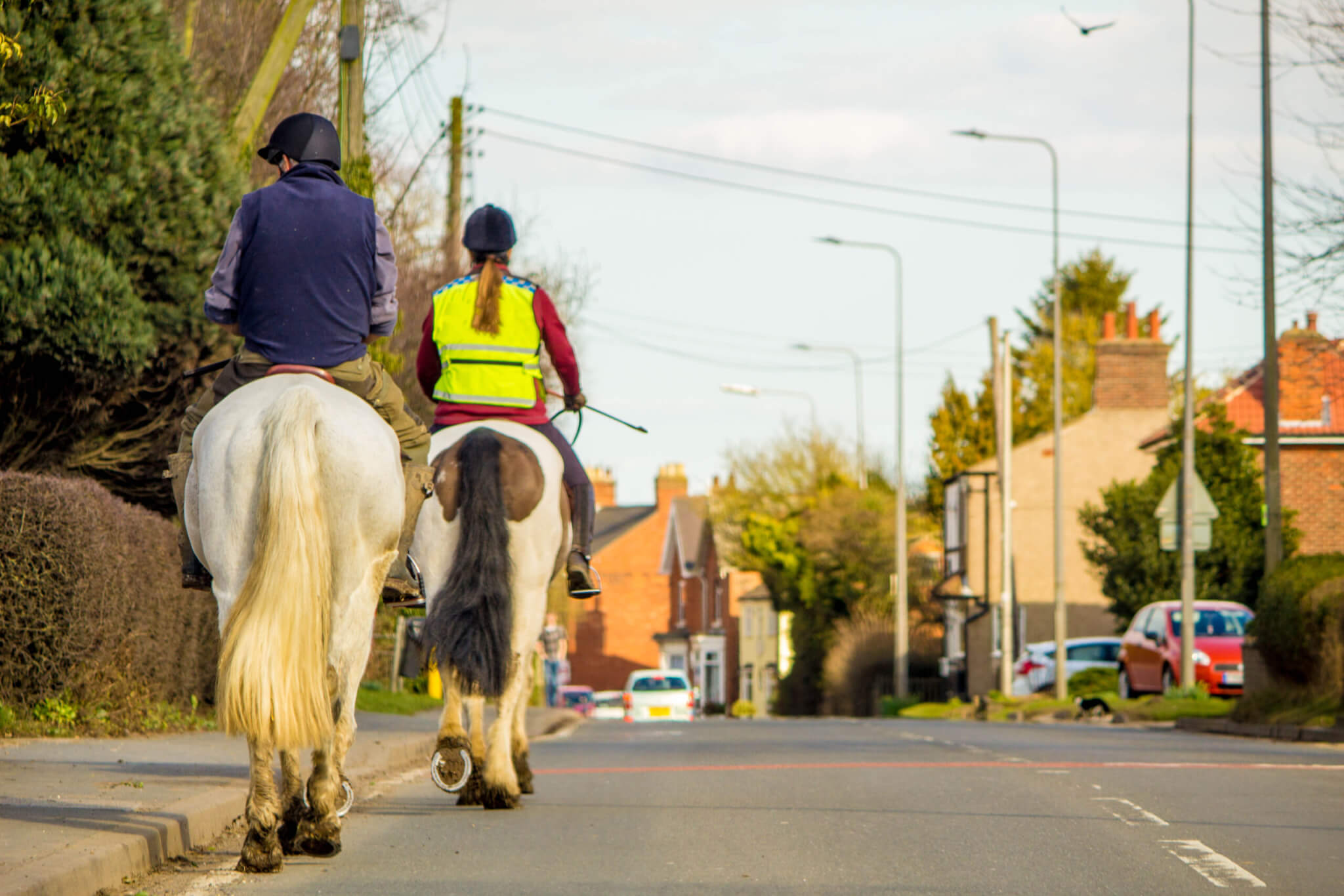Few horse riders enjoy using public roads, but those with limited off-road options or who need to travel from one off-road area to another often have little choice. Historically, equestrian road safety received little scrutiny despite horses and their riders being among the most vulnerable of road users.
However, in January 2022, following lobbying from several stakeholders representing different road users, including The British Horse Society (BHS), the Department for Transport updated the Highway Code (HWC) to enhance protection for vulnerable road users.
Here, we explain what those changes were and examine the extent of their impact on the safety of horses and their riders.
What is the purpose of the new hierarchy of road users?
In January 2022, the Highway Code (HWC) was updated to introduce a ‘hierarchy’ of road users for the first time. The principles that motivated these changes centred on enhancing the safety of vulnerable road users: pedestrians, cyclists, and horse riders (and horse-drawn vehicles).
Vulnerable road users are those most likely to suffer injury in a road traffic accident.
Pedestrians are at the top of the hierarchy, followed by cyclists, horse riders and horse-drawn vehicles.
Further down the hierarchy pyramid come the road users who carry the most responsibility for ensuring they do not put the vulnerable members of the hierarchy at risk of injury. This group includes HGVs and passenger vehicles at the bottom of the hierarchy and, above them, vans, minibuses, cars, and motorcycles.
The rules stress that all road users are responsible for looking after their own and each other’s safety.
What are the latest HWC rules relating to horse riders and horse-drawn vehicles?
On its website, the BHS states that 85% of the reported road incidents involving horses in 2023 were caused by vehicles passing too close to the horse and too fast. This statistical fact is backed up by the day-to-day experience of most horse riders who travel on the highway.
When a motorist approaches a horse and rider, there is the additional danger that the horse will spook, causing the rider to become unseated and the horse to bolt out of control. This situation happens when motorists pass too close to horses, often coupled with driving too fast.
On narrow country lanes with hedges on either side, a horse may also spook if it sees traffic coming towards it because it may feel there is insufficient room between the vehicle and the hedge to pass safely.
Therefore, horse riders pleaded that any amendments to the Highway Code needed to address the problem of vehicles travelling too fast when near horses on the road and impress upon motorists the need to allow plenty of room when passing.
With this in mind, Rule 215 of the Highway Code now provides as follows:
- Drivers should carefully approach, overtake, pass, or move away from horse riders or horse-drawn vehicles.
- Drivers should pass horse riders or horse-drawn vehicles wide and slowly.
- When they see a horse on the road, drivers should slow down to a maximum of 10 mph.
- When they see a horse on the road, drivers should be patient and refrain from sounding horns or revving their engines.
- When safe, drivers should pass the horse wide and slow, allowing at least 2 meters of space.
- Horse riders are often children, so drivers should take extra care and appreciate that riders may ride in double file when more experienced riders need to escort less experienced ones.
- Drivers should look out for and take heed of a horse rider’s request that they slow down or stop.
- Drivers should acknowledge horses’ unpredictability and treat them all as potential hazards. Horses are flight animals and can move quickly and unexpectedly when startled.
Rule 215 applies equally to feral or semi-feral ponies often encountered in areas such as Dartmoor, Exmoor and the New Forest.
What are the consequences of failing to comply with Rule 215 of the Highway Code?
Some of the rules in the Highway Code are legal requirements and supported by equivalent road traffic laws. You can spot which rules of the Code you must comply with to avoid breaking the law, as they use the words MUST or MUST NOT.
For example, Rule 123 of the Code states:
“You MUST NOT leave a parked vehicle unattended with the engine running…” Should you do so, you may find yourself facing a criminal prosecution.
The provisions of Rule 215 are not compulsory, meaning the Police can’t prosecute road users for failing to comply with the Rule.
However, let’s suppose a motorist causes a horse to bolt by driving too fast and not leaving enough room to pass the horse safely. The rider is unseated and thrown to the ground, causing injury to the rider. In any subsequent horse riding accident claim brought by the rider, the driver’s failure to observe the advice provided by rule 215 can be used as evidence to support the horse rider’s legal case.
What impact have the alterations to the Highway Code had on the safety of horses and their riders?
The press reported a drop in incidents involving horses on the road in the immediate aftermath of the changes. For a short while, the horse-riding community had a general feeling of optimism that things were improving. However, their hopefulness was short-lived since matters have not continued along such a positive trajectory in the intervening years.
Over a year after the Department for Transport updated the Highway Code, the BHS reported a rising number of incidents involving horses on the roads.
In 2023 alone, over 3,383 road incidents involving horses were reported to the BHS. Of these:
- 66 incidents led to the death of a horse,
- 86 accidents caused injuries to a horse
- Three riders lost their lives in fatal accidents
- Ninety-four riders sustained injury as a result of a road traffic accident.
One of the primary reasons for this apparent lack of a lasting positive impact from the rule changes is that many drivers are unaware of the latest changes to the Highway Code’s guidance. A survey carried out by the road safety charity IAM RoadSmart reported that:
- Over half of the road users questioned could not remember the last time they referred to the Highway Code.
- One in five motorists surveyed were utterly oblivious to the changes to the Highway Code.
The BHS continues to increase awareness and improve the safety of horses and their riders through its ‘Dead Slow’ campaign. The campaign seeks to educate horse riders and other road users about how to act if they encounter each other on the roads.
Do horse riders believe the changes to the Highway Code have made any difference to their safety?
We asked members of a Facebook group dedicated to horse riding on the road for their views and experiences of drivers passing wide and slow following Rule 215 of the HWC.
Here’s a summary of what some of them had to say:
- A few drivers slow down to 10mph or less. According to some of the riders in the group, many drivers still think 30mph is slow enough, and the rest don’t bother slowing down at all.
- Riders believe the only time many motorists’ driving standards improve when passing horses is for a short window following media coverage, such as news reports on the changes to the HWC or after incidents involving horses, like the incident in London in April 2024 when military horses belonging to the household cavalry ran amok in the capital after being spooked by noises thought to have emanated from a construction site.
- Most riders who responded believe laws need to be passed, making it a criminal offence not to slow down and pass horses slowly and at a minimum distance of 2 metres.
- More driver education is required through TV advertising campaigns that run over many weeks or even months, not just sporadically.
- Many drivers slow down even if it’s not to 10 mph, but far less pass at a safe distance from the horse.
- Many riders wear webcams to record any dangerous driving they experience and pass it on to the Police for a decision on whether to prosecute the drivers involved should they deem an offence has occurred. In some cases, this has led to prosecutions for driving offences.
- When challenged by some of the riders, a number of drivers responded by saying they did not know about the amendments to the HWC in 2021.
- On the other hand, other drivers, when challenged, have indicated they know about the new rules, but as they are not MUST rules, they are also aware they don’t commit an offence by driving too close to horses or not reducing their speed when passing them.
Conclusion
The concept of a hierarchy of road users was very much at the heart of updating the Highway Code in 2022. For horse riders, it was imperative that the problems caused by motorists passing horses on the road at excessive speeds and without giving enough room were addressed.
Rule 215 of the HWC recommends a safe speed and minimum passing distance for motorists when overtaking horses.
However, the fact that the Rule is merely advisory and not mandatory highlights the HWC’s limitations. Coupled with evidence that many motorists are ignorant of not only the new updates to the HWC but of the rules in general, the effectiveness of Rule 215 and other updates intended to make vulnerable road users safer is in doubt.
The horse riders we contacted believe that only by making Rule 215 mandatory will we see drivers slowing down and giving horses the requisite wide berth when passing. If that were to happen, fewer riders and horses might be injured or killed.
Visit our horse riding accident claims webpage for more in-depth information about horse riding accident claims in general, not just those that take place on roads.
Mooneerams are a niche firm of personal injury solicitors. We only handle personal injury claims, and we only act for claimants.
Our solicitors have vast experience in all types of personal injury claims. We have handled claims for numerous riders injured in horse-riding accidents caused by another person’s negligence, including those involved in horse-riding accidents on the road.
We firmly believe that anyone injured in an accident that wasn’t their fault should be able to claim the compensation they deserve. Mooneerams act for most clients on a No Win No Fee basis.









